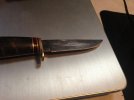- Joined
- Nov 15, 2013
- Messages
- 59
I am not sure how this happened. I have a ten yr old daughter that loves my knives so maybe that explains it. There is rust ( from hand oils ) and scratches on the side of the blades. I've taken 2 different grit buffer wheels to this thing with jeweled rouge ( it sure did shine up) but the scratches are still there. Any ideas?




